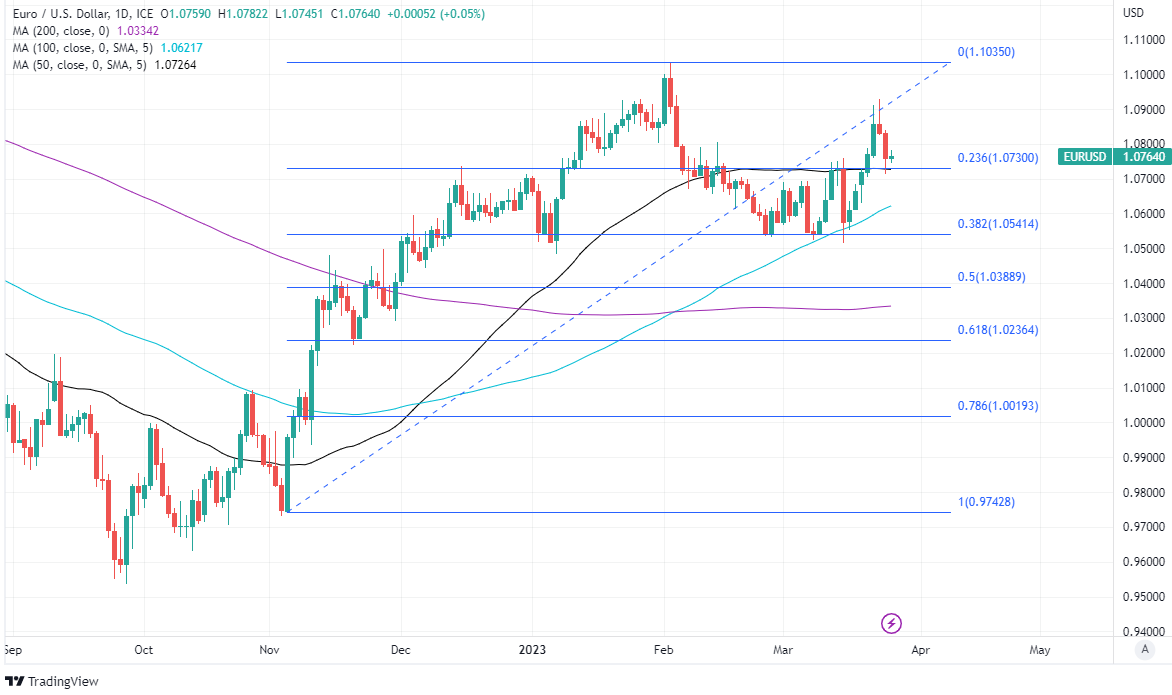EUR/USD Week Ahead Forecast: Tests Waters Beyond 1.08 as CPI Data Eyed
- Written by: James Skinner
-
- EUR/USD supported at 1.0725 & 1.0621 short-term
- Scope for a further attempted recovery beyond 1.08
- If banking sector steadies & Euro inflation surprises

Image © European Commission Audiovisual Services
The Euro to Dollar exchange rate's March recovery was undermined last week but the single currency could further test the waters beyond 1.08 in the days ahead as concerns about the stability of the banking sector dissipate and the European Central Bank (ECB) interest rate outlook comes back into focus.
Europe's single currency had traded up to six-week highs above 1.09 against the Dollar last week before financial markets began asking questions about the stability of a large German bank, leading to losses for risky assets a corrective setback for otherwise outperforming Euro exchange rates.
"While our general view favours a higher EUR/USD on the back of monetary policy divergence, last Friday brought a warning not to jump to the conclusion that this banking turmoil is turning into a US-only story – and therefore into a straight-line bullish EUR/USD," says Francesco Pesole, an FX strategist at ING.
"Still, a move to 1.10 in the coming weeks remains a very tangible possibility. For this week, re-testing 1.0900 would already be a very welcome sign for EUR/USD bulls," Pesole writes in a Monday market commentary.
Euros were bought selectively against other currencies on Monday German banking shares rose alongside the main stock index and a rebound for markets elsewhere, helping the Euro-Dollar rate to enter the new week on the front foot.
Above: Euro to Dollar rate shown at daily intervals with selected moving averages and Fibonacci retracements of November rally indicating possible areas of technical support for the Euro. Click image for closer inspection.
"Sunlight aside, I think we are still in the phase of aftershocks following US bank failures. This argues for a defensive posture in FX heading into Q2," says Stephen Gallo, a global FX strategist at BMO Capital Markets.
"In EURUSD, rallies into the 1.08-1.10 range should be a fade until investors are able to move beyond issues pertaining to European financial stress. I would argue that we're not completely out of the woods yet in this regard: my 1M EURUSD view is 1.06," Gallo writes in a Monday research note.
Opinions about the outlook for the single currency differ markedly, however, and much about how the Euro-Dollar pair fares this week is likely to be determined by European and U.S. inflation figures due out on Friday, which will bring the ECB policy outlook back into focus for the market.
"Spain and Germany will release their CPIs on Thursday in the lead up to the Eurozone wide measure on Friday. Stronger outcomes for Spain and Germany can support EUR/USD," writes Joseph Capurso, head of international economics at Commonwealth Bank of Australia, in a Monday research briefing.
"The outcomes from these economies usually take the surprise out of the Eurozone measure. A further acceleration in core inflation in March can keep more interest rate hikes from the ECB on the table. The next level of upside resistance for EUR/USD is a long way away at 1.1185 (100% Fibbo)," he adds.
Above: Quantitative model-derived estimates of probable trading ranges for selected currency pairs this week. Source Pound Sterling Live. (If you are looking to protect or boost your international payment budget you could consider securing today's rate for use in the future, or set an order for your ideal rate when it is achieved, more information can be found here.)
The consensus among economists sees Eurozone inflation as likely to fall from 8.5% to 7.5% for the month of March on Friday but also looks for the more important core inflation rate to rise from 5.6% to 5.7%.
This is after the ECB upgraded its forecasts for economic growth earlier in March and lifted projections for core inflation, which is thought to better reflect domestic inflation pressures by overlooking volatile food and energy prices.
"Headline inflation will decline quite rapidly over the next six to seven months as the base effects play in favour of a rapid reduction in inflation. What we want to see is a steady and clear convergence towards the 2 per cent target," ECB Vice President Luis de Guindos told Business Post at the weekend.
"In that respect, core inflation is going to be key. It is very difficult to converge towards the 2 per cent target in a sustainable way without a clear decline in core inflation," he also said in an interview with the business newspaper.
While the ECB's outlook for the continental economy improved this month the bank gave no guidance about the extent to which it might still lift interest rates owing to the failure of Silicon Valley Bank and others earlier in March, which has since had spillover impacts on the Eurozone.
Above: Futures market-implied expectations for Fed Funds interest rate later this year. Click image for closer inspection. To optimise the timing of international payments you could consider setting a free FX rate alert here.
The bank said in place of guidance about interest rates that future policy decisions would be entirely dependent on data emerging from the Eurozone economy, although last week's UK inflation figures suggest - if anything - that risks around this Friday's European numbers might be on the upside.
Any upside surprise in European inflation would potentially lead markets to bank on further increases in ECB interest rates at a point when the Federal Reserve policy stance is depriving the Dollar of support that would otherwise be gained from additional or better-sustained increases in bond yields.
"If we need to raise rates higher, we will. I think for now though, we, as I've mentioned, we see the likelihood of credit tightening," Federal Reserve (Fed) Chairman Jerome Powell said at last Wednesday's press conference.
"We know that that can have a, you know, an effect on the macro economy, on demand, on labor market conditions and we're gonna be watching to see what that is," he added in response to questions from reporters.
The Fed's willingness to allow "credit tightening" to do the work of higher borrowing costs could help the Euro-Dollar rate to better navigate this Friday's release of the Core PCE Price Index for February, which is the Fed's preferred measure of inflation and the highlight of the U.S. calendar for the week ahead.
Above: Euro to Dollar rate shown at weekly intervals with Fibonacci retracements of May 2021 and February 2022 downtrends indicating possible areas of technical resistance for the Euro. Click image for closer inspection.


